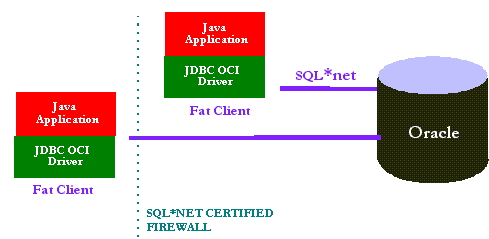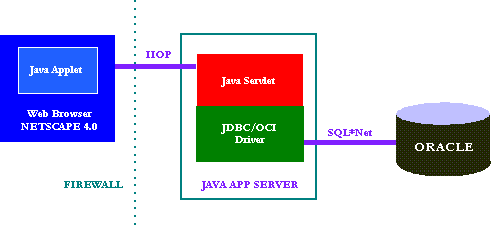Database Connection System Architectures
2-Tier Architecture

OR

The above is a traditional 2-tier client-server architectures. The
first uses Oracle and JDBC OCI driver (hence only for a Java Applicatio).
The second diagram shows a 2-tier client-server architecture for Java
Applet using the Thin JDBC driver.
ISSUES:
State Management:
In this configuration, the initial communication between the
client and middle-tier web server occurs via the stateless HTTP
protocol. Once the JDBC driver has been downloaded, it establishes
a direct connection with the Oracle database. This connection
is stateful and the JDBC driver therefore eliminates the need
for the Java application programmer to explicitly handle the relationship
between transaction state and various HTTP sessions. However,
in this configuration the JDBC driver does establish a separate
connection from each web browser to the Oracle database.
Greater scalability:
Since the JDBC driver does establish a separate connection
from the web browser to the database server, there are two ways
in which a user can achieve greater scalability i.e. support a
large number of browsers connected concurrently to a single database.
First, the user can connect the browsers to the database via the
Net8 Connection Manager which essentially multiplexes connections
between a number of different clients to a single physical database
connection. This reduces the number of direct database connections
and therefore provides greater scalability particularly on platforms
which have limitations in the number of physical end points that
they support. Second, with the Oracle8 database server, the user
can transparently leverage a feature called connection pooling.
Essentially the Oracle Multi Threaded Server's dispatcher establishes
a pool of connections internally and hands connections from inactive
to active clients thereby supporting more clients than connections
and thereby facilitating greater scalability. The application
developer does not need to write any application code to leverage
this capability.
Security Considerations:
The communication between an applet that uses the JDBC driver
and the Oracle database happens over Java TCP/IP sockets. In
the case of the Java Applet, the connection can only be
made if the web browser where the applet is executing allows a
sockets connection to be made. In a JDK1.0.2-based Web browser,
such as Netscape 3.0, an applet can only open sockets to the host
from which it was downloaded. Therefore, to avoid violating JDK
1.0.2. security considerations, the Oracle Database server must
be physically located on the same machine as the web server. However,
this restriction has been eliminated for JDK 1.1 signed
applets in which case the web server and the Oracle database
can be deployed on two separate machines. In a JDK 1.1.1 based
web browser, such as Netscape 4.0, an applet can request socket
connection privileges and, if the user grants them, the applet
can connect to the database running on a different host from the
web server host. Another alternative besides
signed applets, to avoid this security restriction is to use the
Oracle Connection Manager.
|
3-Tier Architecture

OR

The above is a 3-tier client-server-server architecture using Oracle
and JDBC OCI driver. Here there is a middle Java w/JDBC application that
sits on the server and client application or applet communicates with
it via HTTP calls (or you could use sockets).
The middle JDBC application is responsible for connecting to the
Database and performing queries. This is done in the same way the 2-tier
Java application connects.
Besides the JDBC application, the JDBC driver must be installed
on the server.
The server which the middle JDBC application and driver sits on
may be physically different or the same as the Database server machine.
|
HOW TO INVOKE THE middle JDBC application:
- The user can use a CGI script that invokes it.
- Implement the JDBC application as a Servlet.
- Use Oracle's Web Request Broker API [if the application
is deployed on Oracle's Web Application Server].
- Have the JDBC application be persistant (continually running)
and instead of invoking it using HTTP the client application/applet
communicates via a Sockets to make requests.
- Implement a IIOP
style invocation. (short for Internet Inter-ORB Protocol,
a protocol developed by the Object Management Group (OMG) to
implement CORBA solutions over the World Wide Web. IIOP enables
browsers and servers to exchange integers, arrays, and more
complex objects, unlike HTTP, which only supports transmission
of text. )
|
Advantages of 3-Tier over 2-Tier
State Management:
In this configuration, the communication between the client
and middle-tier web server occurs via HTTP, a stateless or connectionless
protocol; while the communication between the Java application
on the web server and the database occurs in a stateful manner.
The Java application programmer needs to explicitly manage all
of the state information and handle all of the relationships between
transaction state and various HTTP sessions.
Greater scalability:
Further, in this connection, a sophisticated Java application
programmer will leverage the capabilities of the JDBC/OCI driver
for greater scalability. For instance, rather than establish a
separate database connection for every web browser, the application
developer may choose to pool the state associated with multiple
clients on a single or a limited number of connections to the
backend database server. By choosing to allocate a pool of database
connections which can then be reused, the Java programmer optimizes
database server memory usage and significantly increases the number
of clients i.e. browsers that the application can support.
Optimized response time:
Since HTTP is by its nature a stateless protocol, a simplistic
Java application would essentially require a user to establish
a database connection and login each time. With HTTP's stateless
nature, this creates severe performance issues associated with
a separate web server to database server round trip and a database
login for each HTTP request. This can be prohibitively expensive
from a performance and responsiveness standpoint. To avoid this,
a sophisticated Java programmer will choose to establish a database
connection and login the user on the initial invocation; after
the initial connection, the programmer will cache the database
connection and login context and reuse them on subsequent HTTP
requests from the same user to avoid making mid-tier to database
server round trips.
|
|



